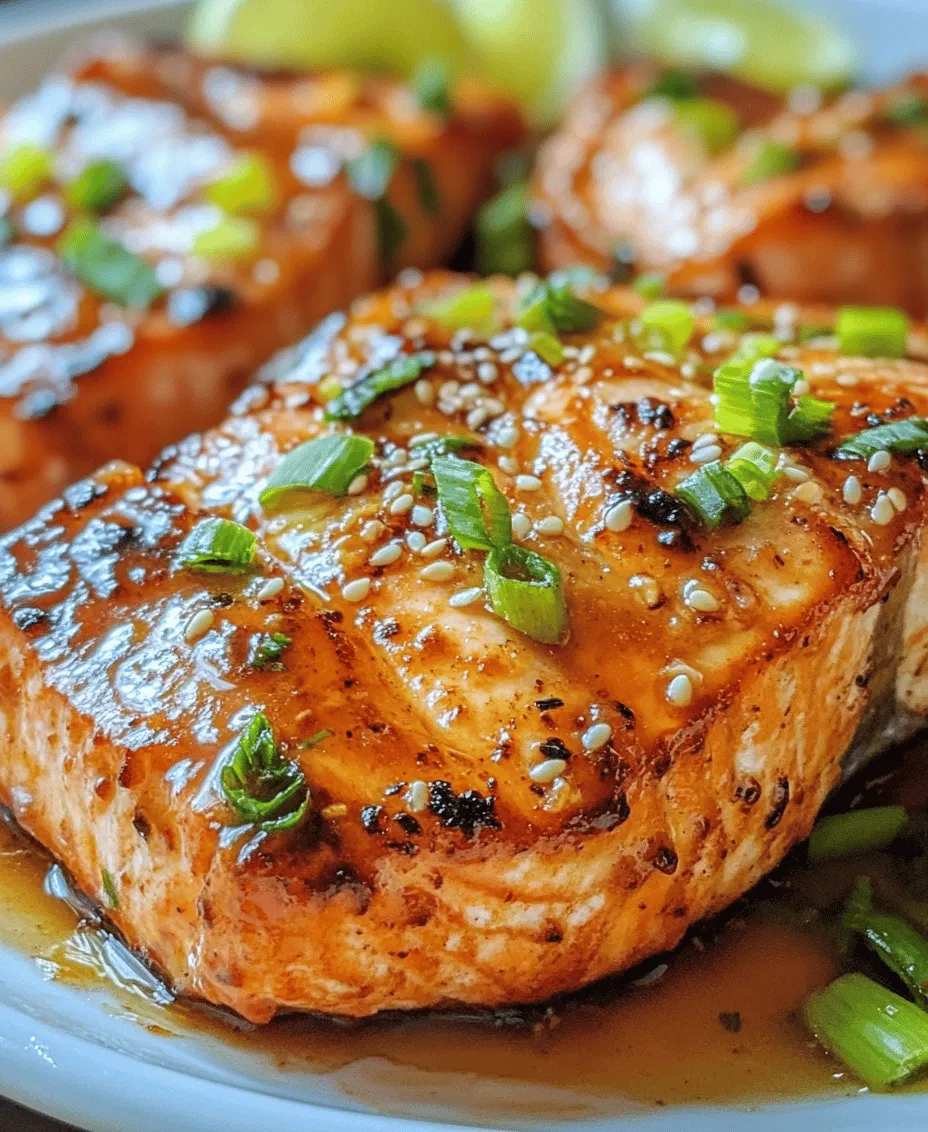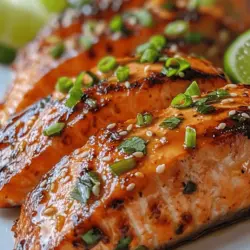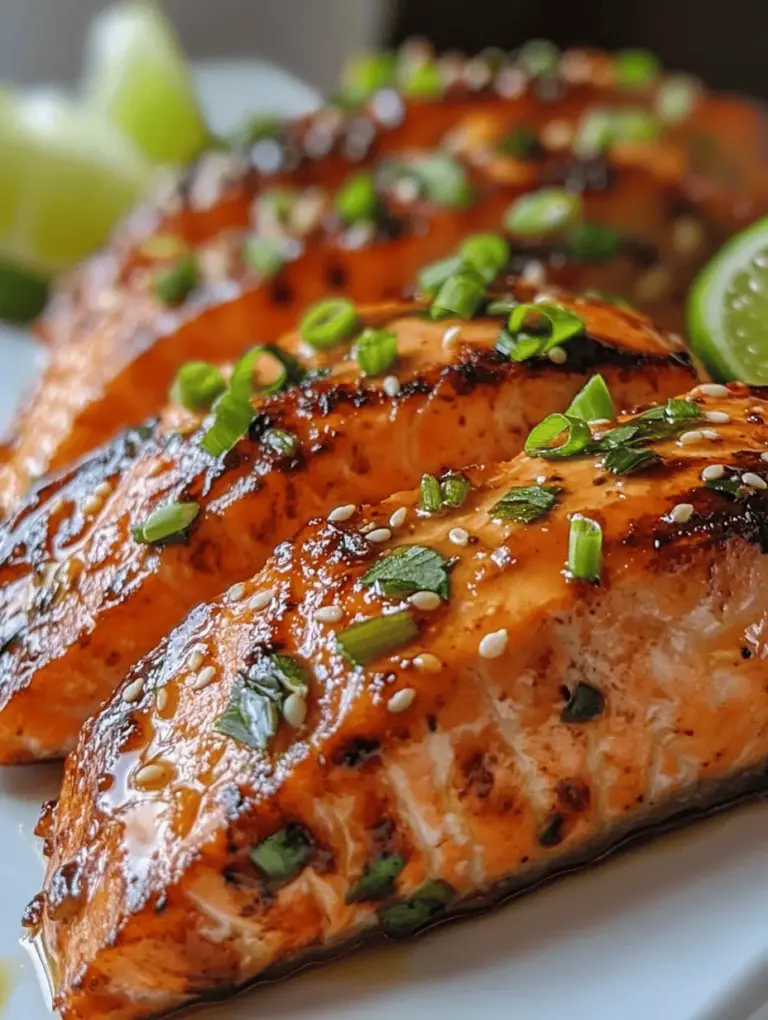Introduction
If you’re searching for a quick, delectable meal that combines the rich flavors of savory teriyaki with the health benefits of salmon, look no further than this Savory Baked Teriyaki Salmon recipe. This dish not only makes for a delightful dinner but also packs a nutritional punch that caters to both taste and health-conscious eaters. Salmon is renowned for its rich omega-3 fatty acids, making it an ideal seafood option for anyone looking to improve their diet while enjoying a meal that tastes as good as it looks.
Teriyaki sauce, which originates from Japan, is known for its unique flavor profile that blends sweetness, saltiness, and an umami depth. This sauce turns an ordinary piece of salmon into a culinary masterpiece, creating a delightful fusion of flavors that will tantalize your taste buds. What makes this recipe even more appealing is its simplicity and quick preparation time. With just a handful of ingredients and minimal effort, you can whip up a restaurant-quality dish right in your kitchen.
Understanding Salmon: Nutritional Benefits and Varieties
Salmon stands out as one of the most popular fish options available, not only for its flavor but also for its numerous health benefits. As a high-quality protein source, salmon is packed with essential nutrients that are crucial for maintaining a balanced diet. It is rich in omega-3 fatty acids, which are known for their ability to support heart health, reduce inflammation, and promote brain function. Additionally, salmon contains a host of vitamins and minerals, including vitamin B12, vitamin D, selenium, and potassium, all of which contribute to overall well-being.
When it comes to selecting salmon, it’s important to understand the different varieties available. The most common types of salmon include:
– Atlantic Salmon: Typically farmed, Atlantic salmon is known for its mild flavor and high fat content, making it rich and buttery.
– Sockeye Salmon: This wild-caught variety has a deeper red hue and a more robust flavor profile, making it a favorite among chefs and home cooks alike.
– Coho Salmon: Slightly milder than sockeye, coho salmon has a firm texture and a subtle flavor, offering a good balance of richness.
Beyond flavor and texture, sustainability is a growing concern in seafood sourcing. Opting for sustainably sourced salmon not only benefits your health but also contributes to the preservation of marine environments. Look for certifications such as the Marine Stewardship Council (MSC) or the Aquaculture Stewardship Council (ASC) when selecting your salmon to ensure you are making environmentally conscious choices.
The Allure of Teriyaki Sauce
Teriyaki sauce is a staple in Japanese cuisine, known for its ability to elevate a wide range of dishes. The origins of teriyaki date back to the Edo period (1603-1868), where it was used to glaze grilled meats. Over the years, it has evolved into the beloved sauce we know today, characterized by its perfect balance of sweet and savory flavors.
The key ingredients that make up traditional teriyaki sauce include soy sauce, mirin (a sweet rice wine), sake, and sugar. This combination creates a sauce that is both sweet and salty, with a rich umami flavor that complements various proteins, particularly fish. While store-bought teriyaki sauces are widely available, making your own at home allows you to control the ingredients and customize the flavor to your liking.
When comparing store-bought versus homemade teriyaki sauce, it’s essential to note that homemade versions often have fresher flavors and fewer preservatives. If you’re short on time, a quality store-bought option can be just as effective in delivering the delicious taste you’re after. Regardless of the choice, teriyaki sauce adds a delightful glaze that transforms salmon into a mouthwatering dish.
Gathering Your Ingredients
To prepare this Savory Baked Teriyaki Salmon, you will need a few essential ingredients that are easy to find and relatively simple to work with. Here’s a detailed description of what you will need:
Essential Ingredients:
1. Salmon Fillets: The star of the dish. When selecting salmon, aim for fresh, high-quality fillets. Look for vibrant color and firm texture. If possible, choose wild-caught salmon for its superior flavor and health benefits.
2. Teriyaki Sauce: You can either opt for store-bought teriyaki sauce or make your own at home. If you choose to make your own, you’ll need soy sauce, mirin, sake, and sugar. This flexibility allows you to cater to dietary preferences and flavor preferences.
3. Green Onions: Chopped green onions add a fresh, aromatic touch that enhances the overall presentation and flavor of the dish.
4. Sesame Seeds: Toasted sesame seeds contribute a delightful crunch and nutty flavor, making your dish visually appealing and texturally interesting.
5. Optional Ingredients: Consider adding garlic or ginger for an extra layer of flavor, or serve the salmon over a bed of rice or alongside steamed vegetables for a complete meal.
With these ingredients on hand, you’re well on your way to creating a savory baked teriyaki salmon that will impress your family and friends while nourishing your body. This dish’s straightforward preparation makes it ideal for busy weeknights or special occasions, ensuring that you can enjoy a satisfying meal without spending hours in the kitchen.
—
In the next section, we will delve into the step-by-step instructions for preparing your Savory Baked Teriyaki Salmon, ensuring that every bite is packed with flavor and goodness. Stay tuned for the cooking process that will elevate your culinary skills and delight your taste buds!

Fresh garlic and ginger play a pivotal role in enhancing the flavor profile of savory baked teriyaki salmon. Garlic adds a robust, aromatic depth, while ginger brings a subtle warmth and spice that complements the richness of the fish. Using fresh ingredients, rather than dried or powdered versions, ensures that the dish is fragrant and vibrant, elevating it from ordinary to extraordinary. The oils released from freshly minced garlic and ginger meld beautifully with the teriyaki marinade, creating a harmonious blend of flavors that permeate the salmon.
Sesame oil is another crucial component in this recipe, known for its nutty flavor and aroma. It enhances the overall taste of the dish and adds a glossy finish that is visually appealing. The oil not only enriches the marinade but also helps in caramelizing the salmon during the cooking process, resulting in a delightful crispy exterior. When combined with the other ingredients, sesame oil contributes to a well-rounded flavor that keeps diners coming back for more.
Optional garnishes such as chopped green onions, sesame seeds, or cilantro can elevate the presentation and taste of your baked teriyaki salmon. Green onions add a fresh crunch and a pop of color, while sesame seeds provide a nutty bite and visual appeal. Fresh herbs like cilantro can brighten the dish with their vibrant flavor. These garnishes not only make the dish look more enticing but also enhance the overall flavor experience, making each bite more enjoyable.
Step-by-Step Guide to Preparing Savory Baked Teriyaki Salmon
Prepping the Oven
Before diving into the preparation, it’s essential to preheat your oven to 400°F (200°C). Preheating is a crucial step that ensures even cooking throughout the salmon fillets. An adequately heated oven helps achieve the desired texture—crispy on the outside and tender on the inside. Additionally, it minimizes the risk of the fish drying out during the cooking process.
Making the Marinade
To create the teriyaki marinade, you’ll need to combine soy sauce, brown sugar, rice vinegar, freshly minced garlic, and ginger in a medium-sized bowl. Whisk these ingredients together until the sugar dissolves completely. The combination of sweet and savory elements is what makes teriyaki sauce so loved. For an extra layer of flavor, consider adding a splash of sesame oil and a pinch of red pepper flakes for a hint of spice.
Marinating the Salmon
After preparing the marinade, it’s time to marinate the salmon fillets. Place the salmon in a shallow dish or a resealable plastic bag and pour the marinade over it. Ensure that each fillet is well-coated. For optimal flavor infusion, let the salmon marinate in the refrigerator for at least 30 minutes, but if time allows, marinating for up to 2 hours will significantly enhance the taste. Remember to occasionally turn the salmon in the marinade to ensure even flavor distribution.
Preparing the Baking Tray
While the salmon marinates, prepare your baking tray. Line it with parchment paper or aluminum foil for easy cleanup. Not only does this prevent the fish from sticking, but it also makes washing the tray a breeze afterward. Lightly spray or brush the parchment with a bit of cooking oil to further prevent sticking and to promote even browning.
Baking Instructions
Once marinated, place the salmon fillets skin-side down on the prepared baking tray. Drizzle a little of the remaining marinade on top for added flavor. Bake the salmon in the preheated oven for 12-15 minutes, depending on the thickness of the fillets. The key indicators of doneness for salmon are its opaque color and flakiness. An internal temperature of 145°F (63°C) is recommended for safe consumption. Make sure to keep an eye on it; overcooked salmon can become dry and less enjoyable.
Broiling for Perfection
For that irresistible caramelized crust, consider broiling the salmon for the last 2-3 minutes of cooking. Switch your oven setting to broil and move the salmon to the top rack. This intense heat will create a beautiful golden crust while keeping the inside moist. Watch closely during this step to prevent burning; the broiler can quickly turn a delicious dish into a charred one.
Final Touches
Once the salmon has finished baking and broiling, it’s time for the final touches. Transfer the salmon to a serving platter and garnish with your choice of chopped green onions, sesame seeds, or fresh cilantro. These garnishes enhance both the visual appeal and flavor, providing a fresh contrast to the rich, savory salmon.
Serving Suggestions and Pairings
When it comes to serving your savory baked teriyaki salmon, the right sides can elevate the meal even further. Pair it with fluffy jasmine rice or nutty quinoa for a wholesome grain component that balances the dish. These grains soak up the savory teriyaki sauce beautifully, providing a satisfying base for the salmon.
For vegetables, consider serving steamed asparagus or sautéed broccoli. These greens add color and nutrition, and their slight bitterness complements the sweetness of the teriyaki sauce. A simple drizzle of sesame oil over the vegetables or a sprinkle of sesame seeds can tie the flavors together.
To enhance your dining experience, think about beverage pairings. A crisp Sauvignon Blanc or a light Pinot Grigio would complement the salmon well. If you prefer non-alcoholic options, try serving a chilled green tea or sparkling water infused with citrus for a refreshing palate cleanser.
For an attractive presentation, serve the salmon on a large platter with the garnishes artfully arranged. You might also consider adding lemon wedges or lime slices for guests to squeeze over their fish. This not only provides a pop of color but also adds a zesty brightness that contrasts nicely with the rich teriyaki flavors.
Conclusion
The savory baked teriyaki salmon recipe showcases the simplicity and versatility of cooking fish at home. With its vibrant flavors and easy preparation, this dish is perfect for weeknight dinners or special occasions alike. Incorporating salmon into your regular meal rotation not only offers a delicious dining experience but also provides essential nutrients like omega-3 fatty acids, making it a heart-healthy choice.
As you experiment with this recipe, feel free to adapt the ingredients and sides to suit your taste preferences. Whether you enjoy it with rice, quinoa, or a medley of seasonal vegetables, baked teriyaki salmon can fit seamlessly into various meal contexts. So, roll up your sleeves, gather your ingredients, and enjoy a delightful culinary adventure with this savory salmon dish.

